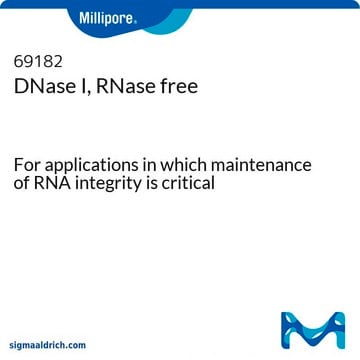11284932001
Roche
DNase I
from bovine pancreas
Synonym(s):
Dnase
Sign Into View Organizational & Contract Pricing
All Photos(1)
About This Item
Recommended Products
biological source
bovine pancreas
Quality Level
form
lyophilized
packaging
pkg of 100 mg
manufacturer/tradename
Roche
technique(s)
cell culture | mammalian: suitable
storage temp.
2-8°C
Related Categories
General description
DNase I is a double-strand specific endonuclease that degrades DNA. Bovine pancreatic deoxyribonuclease I (DNase I) is a DNA minor grove-interacting nuclease, which shows relatively low specificity. This protein is composed of two central β sheets, each composed of six β-strands. This structure is surrounded by extensive loop and α-helical regions. This enzyme shares structural similarity to exonuclease III. DNase I is one of the most well characterized endonucleases of mammalian origin.
Application
DNase I has been used for tissue dissociation in conjunction with collagenases.
Biochem/physiol Actions
During tissue dissociation, parts of the cells are lysed resulting in a release of DNA. Monomolecular DNA may cause clumping of cells. Addition of DNase I to the dissociation buffer leads to a degradation of this extracellular DNA, therby avoiding the loss of cells from undesired clumping.
Features and Benefits
- Lyophilized
- Filtered through 0.2 μm pore size membrane before lyophilization
- Glycoprotein and double-strand-specific endonuclease
Unit Definition
One unit is the enzyme activity which yields an increase in absorbance of 0.001 per minute under the assay conditions.
Preparation Note
Activator: Bivalent metal ions (Ca2+, Mg2+)
Working concentration: 0.01 to 1 mg/ml
Note: For each cell type the working concentration has to be determined individually. For optimal activity the enzyme needs 5 mM Mg2+.
Working concentration: 0.01 to 1 mg/ml
Note: For each cell type the working concentration has to be determined individually. For optimal activity the enzyme needs 5 mM Mg2+.
Reconstitution
Reconstitute the lyophylizate in sterile double-distilled water (10 mg/ml); further dilution with PBS (phosphate buffered saline), HBSS (Hank′s Balanced Salt Solution) or medium.
Other Notes
For life science research only. Not for use in diagnostic procedures.
Signal Word
Danger
Hazard Statements
Precautionary Statements
Hazard Classifications
Resp. Sens. 1 - Skin Sens. 1
Storage Class Code
11 - Combustible Solids
WGK
WGK 1
Flash Point(F)
does not flash
Flash Point(C)
does not flash
Certificates of Analysis (COA)
Search for Certificates of Analysis (COA) by entering the products Lot/Batch Number. Lot and Batch Numbers can be found on a product’s label following the words ‘Lot’ or ‘Batch’.
Already Own This Product?
Find documentation for the products that you have recently purchased in the Document Library.
Customers Also Viewed
Karoline Möller et al.
Experimental & translational stroke medicine, 4(1), 20-20 (2012-10-04)
The pathophysiology of sterile inflammation following focal ischemic stroke is complex and not fully understood, but there is growing evidence that it offers several therapeutic options beyond the hitherto existing treatment strategies. The identification and quantification of infiltrating inflammatory cells
Burkhard Steuernagel et al.
Plant physiology, 183(2), 468-482 (2020-03-19)
Disease resistance genes encoding nucleotide-binding and leucine-rich repeat (NLR) intracellular immune receptor proteins detect pathogens by the presence of pathogen effectors. Plant genomes typically contain hundreds of NLR-encoding genes. The availability of the hexaploid wheat (Triticum aestivum) cultivar Chinese Spring
Yutaka Takeuchi et al.
Biology of reproduction, 81(6), 1055-1063 (2009-07-17)
In a recently established system for intraperitoneal spermatogonial cell transplantation in salmonids, donor type A spermatogonia (type A SG) were microinjected into the peritoneal cavity of newly hatched larvae. Compared with salmonids, the larvae of marine teleosts are small and
Gareth B Kitchen et al.
Proceedings of the National Academy of Sciences of the United States of America, 117(3), 1543-1551 (2020-01-05)
The circadian clock regulates many aspects of immunity. Bacterial infections are affected by time of day, but the mechanisms involved remain undefined. Here we show that loss of the core clock protein BMAL1 in macrophages confers protection against pneumococcal pneumonia.
Hao-Cheng Zheng et al.
Journal of asthma and allergy, 13, 509-520 (2020-10-30)
In China, lamb and fish are well-known triggers for an asthma attack. Our investigation aims at assessing whether the long-term intake of lamb meat or Basa fish would aggravate pulmonary inflammation as well as exploring changes in the intestinal microbiota
Our team of scientists has experience in all areas of research including Life Science, Material Science, Chemical Synthesis, Chromatography, Analytical and many others.
Contact Technical Service












